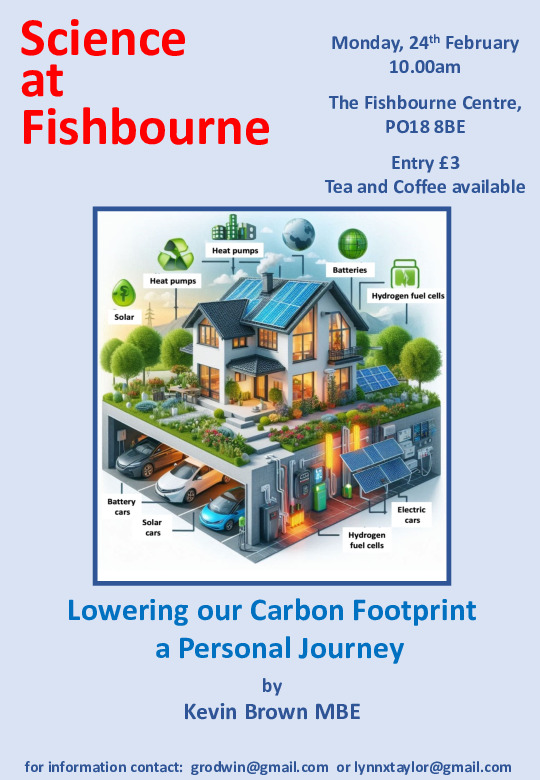
Overview
Since moving to Fishbourne, 6 years ago, we have been lowering our Carbon footprint. My talk will cover some interesting things that I have learned on the way. There often seems to be misinformation about these topics in the press and I will explain the science to enable us all to make good decisions. Heat Pumps, are they hype, do they really work and how well? Solar Panels, how much do they help? Home batteries, are they worth the expense? What about Hydrogen? Plus other interesting information. The talk will be about science in a practical setting and I am expecting that it will provoke some lively discussion.
- Kevin’s presentation: Lowering Our Carbon Footprint
- Protons for Breakfast: Retrofit Journeys
Lynn’s Review
Last year Kevin gave us detailed information on Elekta MRI Radiotherapy units, and this week, his presentation was based on his own experience of installing a heat pump; a project which may directly affect us all in our homes if we are considering replacing our heating systems. Energy costs continue to rise, and so many new advances and changes are on the horizon that it’s good to receive such well researched information.
Fortunately, Kevin has provided us with his slides, and also with information from a blog called, ‘Protons for Breakfast.’ (both linked above)
I need only summarise some of the important points:
Gas and electric heating will give out energy equal to that which is put in to run the system. A heat pump will provide more heat than the energy put in. This ratio is the CoP and Kevin showed a CoP of 4, i.e. 4kw of heat into the home, from an input of 1kw to run the heat pump. Together with the right tariff this makes a heat pump much cheaper to run than gas.
It’s important to set the Flow Temperature correctly to maximise efficiency; set it too cool and the house isn’t warm, and set it too hot, then efficiency is compromised.
Good insulation is one of the best investments you can make, it not only reduces the amount of heat that you need but it also makes a heat pump more efficient.
A British company called; Homely (https://www.homelyenergy.com/) have developed a heat pump micro controller that automatically maximises all aspects of heat production and cost efficiency. Kevin became an installer in order to fit one to his heat pump, and I note that the web site invites you to train to be an installer too! This system, in seeking to use energy when it’s cheaper, may produce more heat sometimes, but this evens out to ensure constant warmth.
Underfloor heating and a large water tank are recommended. If water in the tank is kept at just at the right temperature for showering (45°C is efficient) a 250L tank will be useful.
Radiators work fine with a heat pump, and larger radiators are best, Kevin kept all but two of his original radiators, which he replaced with larger ones to gain the heat required.
Of the more than 190 million heat pumps installed globally around 94% are Air source and 6% are Ground source.
Of note: In Norway 95% of all replaced units are heat pumps, wheras in the UK only 8% of homes use heat pumps, this may be due to negative media coverage. There are government grants for heat pumps at the moment giving £7,500. (https://energy-efficient-home.campaign.gov.uk/heat-pump/)
A thermal survey camera is a useful device when installing insulation: Heat the house, then turn off the heating and use the camera to find the cool spots.
Solar panels are also a useful addition, particularly in the Summer (south facing would be best). Kevin is not in favour of battery storage and just sells his surplus energy back to the grid. His average monthly Octopus charge is £69.
Payback on the installation of batteries would take between 7 and 10 years and batteries generally only have a useful life of around 10 years.
Environmentally, the use of lithium batteries is damaging to the countries who mine for it: Australia, Chile and China. The mining causes pollution in the water, and the air; it also causes degradation of the land; of the soil and vegetation. Mining produces large quantities of mineral waste and disrupts habitats.
We also know, from a previous presentation, that lithium isn’t easily extracted and recycled. Dumping lithium batteries would be lethal to the land. The batteries are also highly flammable.
Sodium ion batteries may be with us in the future, and they (according to my internet search): “Have the potential to be more environmentally friendly than lithium-ion batteries. However, the environmental impact depends on a number of factors, including production, recycling, and the end-of-life of the battery.”
Research is also taking place into a solid- state electrolyte and if this is successful, It’s hoped that this ceramic battery might usefully be used in medical devices. (https://www.sciencedirect.com/science/article/abs/pii/S2405829723000569)
Hydrogen, if it replaces gas for heating a home, may cost 6 – 7 times as much as using a heat pump.
I’ve attempted to give the main points, but please now see the 2 attachments from Kevin for a full picture: Lowering Our Carbon Footprint and Retrofit Journeys.